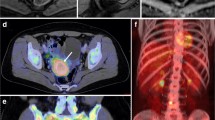Abstract
Purpose
The staging of endometrial cancer requires surgery which carries the risk of morbidity. FDG PET/CT combined with anatomical imaging may reduce the number of unnecessary lymphadenectomies by demonstrating the risk of extrapelvic infiltration. The purpose of this study was to optimize FDG PET/CT diagnostic criteria for risk assessment in endometrial cancer after first-line risk triage with MRI.
Methods
The study population comprised 37 patients who underwent curative surgery for the treatment of endometrial cancer. First, the risk of extrapelvic infiltration was triaged using MRI. Second, multiple glucose metabolic profiles of the primary lesion were assessed with FDG PET/CT, and these were correlated with the histopathological risk of extrapelvic infiltration including lymphovascular space invasion (LVSI) and high-grade malignancy (grades 2 and 3). The results of histological correlation were used to adjust FDG PET/CT diagnostic criteria.
Results
Presurgical assessment using MRI was positive for deep (>50 %) myometrial invasion in 17 patients. The optimal FDG PET/CT diagnostic criteria vary depending on the results of MRI. Specifically, SUVmax (≥16.0) was used to indicate LVSI risk with an overall diagnostic accuracy of 88.2 % in patients with MRI findings showing myometrial invasion. High-grade malignancy did not correlate with any of metabolic profiles in this patient group. In the remaining patients without myometrial invasion, lesion glycolysis (LG) or metabolic volume were better indicators of LVSI than SUVmax with the same diagnostic accuracy of 80.0 %. In addition, LG (≥26.9) predicted high-grade malignancy with an accuracy of 72.2 %. Using the optimized cut-off criteria for LVSI, glucose metabolic profiling of primary lesions correctly predicted lymph node metastasis with an accuracy of 73.0 %, which was comparable with the accuracy of visual assessment for lymph node metastasis using MRI and FDG PET/CT.
Conclusion
FDG PET/CT diagnostic criteria may need adjustment based on the anatomical information provided by MRI. The optimized criteria can predict the risk of pathology-proven LVSI correctly in 83.8 % of patients before surgery, and thus would improve presurgical treatment planning.







Similar content being viewed by others
References
Avril N, Gourtsoyianni S, Reznek R. Gynecological cancers. Methods Mol Biol. 2011;727:171–89.
Kitajima K, Kita M, Suzuki K, Senda M, Nakamoto Y, Sugimura K. Prognostic significance of SUVmax (maximum standardized uptake value) measured by [18F]FDG PET/CT in endometrial cancer. Eur J Nucl Med Mol Imaging. 2012;39:840–5.
Shim SH, Kim DY, Lee DY, Lee SW, Park JY, Lee JJ, et al. Metabolic tumour volume and total lesion glycolysis, measured using preoperative F-FDG PET/CT, predict the recurrence of endometrial cancer. BJOG. 2014;121:1097–106
Todo Y, Sakuragi N. Randomized controlled trial versus comparative cohort study in verifying the therapeutic role of lymphadenectomy in endometrial cancer. Int J Clin Oncol. 2013;18:200–6
Hirata K, Kobayashi K, Wong KP, Manabe O, Surmak A, Tamaki N, et al. A semi-automated technique determining the liver standardized uptake value reference for tumor delineation in FDG PET-CT. PLoS One. 2014;9:e105682.
Patel S, Liyanage SH, Sahdev A, Rockall AG, Reznek RH. Imaging of endometrial and cervical cancer. Insights Imaging. 2010;1:309–28.
McMeekin DS, Lashbrook D, Gold M, Scribner DR, Kamelle S, Tillmanns TD, et al. Nodal distribution and its significance in FIGO stage IIIc endometrial cancer. Gynecol Oncol. 2001;82:375–9.
Tozzi R, Malur S, Koehler C, Schneider A. Analysis of morbidity in patients with endometrial cancer: is there a commitment to offer laparoscopy? Gynecol Oncol. 2005;97:4–9.
Nakamura K, Kodama J, Okumura Y, Hongo A, Kanazawa S, Hiramatsu Y. The SUVmax of 18F-FDG PET correlates with histological grade in endometrial cancer. Int J Gynecol Cancer. 2010;20:110–5.
Lee HJ, Ahn BC, Hong CM, Song BI, Kim HW, Kang S, et al. Preoperative risk stratification using (18)F-FDG PET/CT in women with endometrial cancer. Nuklearmedizin. 2011;50:204–13.
Antonsen SL, Loft A, Fisker R, Nielsen AL, Andersen ES, Høgdall E, et al. SUVmax of 18FDG PET/CT as a predictor of high-risk endometrial cancer patients. Gynecol Oncol. 2013;129:298–303.
Beiderwellen K, Grueneisen J, Ruhlmann V, Buderath P, Aktas B, Heusch P, et al. [18F]FDG PET/MRI vs. PET/CT for whole-body staging in patients with recurrent malignancies of the female pelvis: initial results. Eur J Nucl Med Mol Imaging. 2015;42:56–65
Acknowledgments
The authors thank Hidehiko Omote, RT, Shigeo Oomagari, MSc, and Eriko Suzuki for their support of this study.
Conflicts of interest
None.
Financial support
None.
Author information
Authors and Affiliations
Corresponding author
Rights and permissions
About this article
Cite this article
Sudo, S., Hattori, N., Manabe, O. et al. FDG PET/CT diagnostic criteria may need adjustment based on MRI to estimate the presurgical risk of extrapelvic infiltration in patients with uterine endometrial cancer. Eur J Nucl Med Mol Imaging 42, 676–684 (2015). https://doi.org/10.1007/s00259-014-2964-7
Received:
Accepted:
Published:
Issue Date:
DOI: https://doi.org/10.1007/s00259-014-2964-7




